ADVENTURES of a SEA HUNTER
ADVENTURES OF A SEA HUNTER
JAMES P. DELGADO
IN SEARCH OF Famous Shipwrecks

Copyright 2004 by James P. Delgado
04 05 06 07 08 5 4 3 2 1
All rights reserved. No part of this book may be reproduced, stored in a retrieval system or transmitted, in any form or by any means, without the prior written consent of the publisher or a licence from The Canadian Copyright Licensing Agency (Access Copyright). For a copyright licence, visit www.accesscopyright.ca or call toll free to 1-800-893-5777.
Douglas & Mclntyre Ltd.
2323 Quebec Street, Suite 201
Vancouver, British Columbia
Canada V5T 4S7
www.douglas-mcintyre.com
LIBRARY AND ARCHIVES CANADA CATALOGUING IN PUBLICATION
Delgado, James P
Adventures of a sea hunter : in search of famous shipwrecks/
James P. Delgado; foreword by Clive Cussler.
Includes index.
ISBN 1-55365-071-9
1. Shipwrecks. 2. Underwater archaeology. 3. Delgado, James P. I. Title.
G525.D44 2004 930.102804 C2004-902817-0
Library of Congress information is available upon request
Editing by Saeko Usukawa
Jacket design by Peter Cocking
Text design by Ingrid Paulson
Jacket front photograph: unidentified diver on Ora Verde shipwreck,
Grand Cayman Island, Jeffrey L. Rotman/CORBIS/MAGMA
Printed and bound in Canada by Friesens
Printed on acid-free, forest-friendly, 100% post-consumer
recycled paper processed chlorine-free
Distributed in the U.S. by Publishers Group West
We gratefully acknowledge the financial support of the Canada Council for the Arts, the British Columbia Arts Council, and the Government of Canada through the Book Publishing Industry Development Program (BPIDP) for our publishing activities.
Portions of chapters 6 to 14 previously appeared in a different form in the Vancouver Sun newspaper. Part of the introduction previously appeared in the Washington Post. An account of the dive on USS Arizona appeared in The USS Arizona by Joy Jasper, James P. Delgado and Jim Adams, published by St. Martins Press.
This is for my mother, who had to tolerate human bones and stone tools in her bathtub as I learned about the past as a teenage archeologist. And for making her cry as a middle-aged archeologist who dives in dangerous places because, as she points out, Ill always be her little boy.
This is also for Ann, who keeps the home fires burning while juggling a career and an often missing-in-action archeologist.
And last, for Beau, my faithful feline companion during many an evenings writing marathon. Its not the same without him.
CONTENTS


His stories were what frightened people worst of all. Dreadful stories they wereabout hanging, and walking the plank, and storms at sea, and the Dry Tortugas, and wild deeds and places on the Spanish Main.
ROBERT LOUIS STEVENSON, TREASURE ISLAND
FOREWORD
by Clive Cussler
Ships and their crews have been sailing off into oblivion since the dawn of recorded history. Through the millennia, more than a million ships have sunk or gone missing, along with untold numbers of their crews. A million ships is an impressive statistic not believed by most landsmen. Yet, to call the seven seas a vast cemetery is an understatement.
During the ages, storms have wreaked havoc on entire fleets, some consisting of more than a thousand ships, that were torn apart and hurled to the bottom. The first tragedy may have taken place when one of our Cro-Magnon ancestors happily discovered he could float on water atop a log, at least until he fell off and drowned. From that time forward, huge ships, small boats and men have vanished in an unending surge beneath the waves into dark watery depths that have yet to resurrect their dead.
Except for divers holding their breath and diving in shallow water, shipwrecks seemed as impossible to reach and touch as a rock on the moon. Finally, less than two hundred years ago, divers in hard hats, breathing air pumped down from the surface, started working on the sea bottom and riverbeds. At long last, the sea begrudging began to give up her secrets.
Treasure and salvage came into their own. Salvage became a thriving enterprise, while treasure hunting was about as hit or miss as buying stocks in a bear market. Suddenly, shipwrecks in shallower waters became accessible. The boom was on, and shipwrecks were discovered and studied in a prodigious number of projects. Soon, modern technology enabled the salvage of wrecks thousands of feet deep beneath the seas surface.
The dead in the depths of the sea have no tombstones, no grave markers, nothing to identify their remains that quickly cease to exist. There is an eerie feeling about diving on a shipwreck. You can sense the presence of the crew that died with the ship. A wizened old diver once said that swimming through a shipwreck was like walking through a haunted house.
The last to come on the underwater scene were the marine archeologists. These are about as strange and diverse people as you could ever hope to meet. They seldom become wealthy, and their main claim to fame is in their reports on shipwreck explorations, surveys and artifact removal for conservation and study. Some publish books on their expeditions, some teach, while many work in the commercial end, surveying for government or private corporations that develop properties along waterfronts which might contain history. Not until an accredited archeologist declares the site free of historical artifacts can they begin construction.
Nautical archeologists fight like the furies to preserve a wreck and keep it out of the hands of salvers, treasure hunters and sport divers who are out to pillage shipwrecks of historic significance. Mostly they win, but often they lose the battle to protect a wreck from looters. Their biggest problem is money. Few state, local and federal government agencies have the funding to preserve shipwrecks, so the archeologists squeak by on shoestring budgets from one project to the next.
One who has made a difference is Jim Delgado, a man whose dedication and hard-earned efforts have made a contribution to the field of nautical archeology that cannot be equaled. Of all the archeologists Ive known in my years of chasing after historical shipwrecks, he is one of the few who has his feet on the ground and knows more about lost ships than the Congressional Library and Lloyds of London wrapped up together. His exploits beneath the sea have become legendary.
Im honored and privileged to call him a friend.
INTRODUCTION
THE GREAT MUSEUM of the SEA
For the last thirteen years, I have shared my passion for the past with the public through books and newspaper articles, as a television talking head and host, and as a museum director. After I learned how to dive and embarked on a career with the U.S. National Park Service, I traveled the United States, and then the world, in search of shipwrecks. Not all of them were famous, but in the last few decades, the wrecks Ive been privileged to see and explore have included some notable ones. But what really keeps me fired up with a passion for the past are the connections to everyday people like you and me. Often, its an unidentified wreck or the mute evidence of a life forever interrupted that moves me, and grounds the scientist in the firm reality of the human condition. Recently, Ive enjoyed a new set of adventures in search of famous shipwrecks, thanks to John Davis, producer of the National Geographic International television series
Next page










